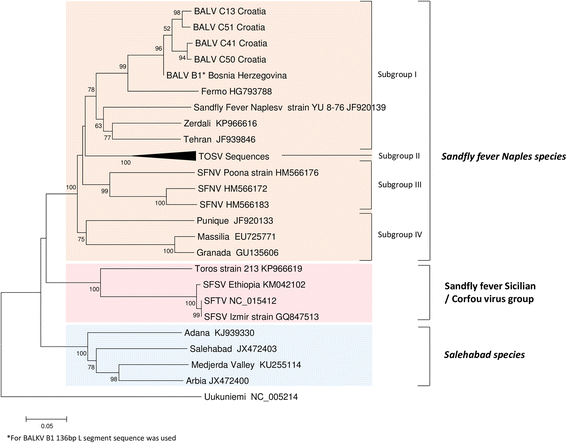Direct evidence for an expanded circulation area of the recently identified Balkan virus (Sandfly fever Naples virus species) in several countries of the Balkan archipelago
- PMID: 28851425
- PMCID: PMC5575908
- DOI: 10.1186/s13071-017-2334-y
Direct evidence for an expanded circulation area of the recently identified Balkan virus (Sandfly fever Naples virus species) in several countries of the Balkan archipelago
Abstract
Background: Recently, Balkan virus (BALKV, family Phenuiviridae, genus Phlebovirus) was discovered in sand flies collected in Albania and genetically characterised as a member of the Sandfly fever Naples species complex. To gain knowledge concerning the geographical area where exposure to BALKV exists, entomological surveys were conducted in 2014 and 2015, in Croatia, Bosnia and Herzegovina (BH), Kosovo, Republic of Macedonia and Serbia.
Results: A total of 2830 sand flies were trapped during 2014 and 2015 campaigns, and organised as 263 pools. BALKV RNA was detected in four pools from Croatia and in one pool from BH. Phylogenetic relationships were examined using sequences in the S and L RNA segments. Study of the diversity between BALKV sequences from Albania, Croatia and BH showed that Albanian sequences were the most divergent (9-11% [NP]) from the others and that Croatian and BH sequences were grouped (0.9-5.4% [NP]; 0.7-5% [L]). The sand fly infection rate of BALKV was 0.26% in BH and 0.27% in Croatia. Identification of the species content of pools using cox1 and cytb partial regions showed that the five BALKV positive pools contained Phlebotomus neglectus DNA; in four pools, P neglectus was the unique species, whereas P. tobbi DNA was also detected in one pool.
Conclusions: We report here (i) the first direct evidence that the Balkan virus initially described in coastal Albania has a much wider dissemination area than originally believed, (ii) two real-time RT-PCR assays that may be useful for further screening of patients presenting with fever of unknown origin that may be caused by Balkan virus infection, (iii) entomological results suggesting that Balkan virus is likely transmitted by Phlebotomus neglectus, and possibly other sand fly species of the subgenus Larroussius. So far, BALKV has been detected only in sand flies. Whether BALKV can cause disease in humans is unknown and remains to be investigated.
Keywords: Arbovirus; Bunyaviridae; Emergence; Fever; Meningitis; Phlebotomus; Phlebovirus; Phylogeny; Sand fly; Toscana virus.
Conflict of interest statement
Ethics approval and consent to participate
Traps were placed near animals with the consent of the owners.
Consent for publication
Not applicable.
Competing interests
The authors declare that they have no competing interests.
Publisher’s Note
Springer Nature remains neutral with regard to jurisdictional claims in published maps and institutional affiliations.
Figures



Similar articles
-
Detection of Leishmania infantum and a Novel Phlebovirus (Balkan Virus) from Sand Flies in Albania.Vector Borne Zoonotic Dis. 2016 Dec;16(12):802-806. doi: 10.1089/vbz.2016.2002. Epub 2016 Oct 27. Vector Borne Zoonotic Dis. 2016. PMID: 27788062
-
High Rates of Neutralizing Antibodies to Toscana and Sandfly Fever Sicilian Viruses in Livestock, Kosovo.Emerg Infect Dis. 2017 Jun;23(6):989-992. doi: 10.3201/eid2306.161929. Emerg Infect Dis. 2017. PMID: 28518045 Free PMC article.
-
Detection of a Novel Phlebovirus (Drin Virus) from Sand Flies in Albania.Viruses. 2019 May 23;11(5):469. doi: 10.3390/v11050469. Viruses. 2019. PMID: 31126034 Free PMC article.
-
An update on Toscana virus distribution, genetics, medical and diagnostic aspects.Clin Microbiol Infect. 2020 Aug;26(8):1017-1023. doi: 10.1016/j.cmi.2019.12.015. Epub 2020 Jan 2. Clin Microbiol Infect. 2020. PMID: 31904562 Review.
-
Sand flies (Diptera: Psychodidae) in eight Balkan countries: historical review and region-wide entomological survey.Parasit Vectors. 2020 Nov 11;13(1):573. doi: 10.1186/s13071-020-04448-w. Parasit Vectors. 2020. PMID: 33176888 Free PMC article. Review.
Cited by
-
Development of a Real-Time PCR Assay for the Detection of the Phlebovirus Fermo Virus.Viruses. 2023 Oct 12;15(10):2082. doi: 10.3390/v15102082. Viruses. 2023. PMID: 37896859 Free PMC article.
-
Revision of the species composition and distribution of Turkish sand flies using DNA barcodes.Parasit Vectors. 2019 Aug 22;12(1):410. doi: 10.1186/s13071-019-3669-3. Parasit Vectors. 2019. PMID: 31439012 Free PMC article.
-
Co-Circulation of Phleboviruses and Leishmania Parasites in Sand Flies from a Single Site in Italy Monitored between 2017 and 2020.Viruses. 2021 Aug 21;13(8):1660. doi: 10.3390/v13081660. Viruses. 2021. PMID: 34452524 Free PMC article.
-
Cocirculation of Two Lineages of Toscana Virus in Croatia.Front Public Health. 2017 Dec 12;5:336. doi: 10.3389/fpubh.2017.00336. eCollection 2017. Front Public Health. 2017. PMID: 29312917 Free PMC article. No abstract available.
-
Genetic Characteristics of Wuxiang Virus in Shanxi Province, China.Viruses. 2024 Jan 10;16(1):103. doi: 10.3390/v16010103. Viruses. 2024. PMID: 38257803 Free PMC article.
References
-
- Depaquit J, Grandadam M, Fouque F, Andry PE, Peyrefitte C. Arthropod-borne viruses transmitted by phlebotomine sand flies in Europe: a review. Euro Surveill. 2010;15(10):19507. - PubMed
MeSH terms
Substances
LinkOut - more resources
Full Text Sources
Other Literature Sources
Miscellaneous

